
Electrostatic Precipitator
Specialists
Events Calendar
News Releases
This Old Box Newsletter
Swap Shop - Used Stuff
Sales Items - New Stuff
Books & References
Employment Opportunities
Professional Organizations
ESP Terminology
ESP Photographs
Consultant
Organizations
OEMs
Rebuild, Parts & Construction
Accessory Products & Equip.
Lab/Testing/Modeling Co.
Contact us at
trkeng@apcnetwork.com
Managed by:
TRK Engineering Services
Information on:
TRK Engineering
Precipitator
Seminars
Remote
Monitoring
|
| Pictures
of Rappers in the ESP |
Back to  |
Rappers are utilized to dislodge material from the
collecting surfaces, discharge electrodes and gas distribution plates.
Improper rapping can lead to spark-over and a reduction in power
levels, high resistance grounds and dead short conditions, reentrainment
of collected material, damage to ESP internal components and distortion of
gas flow.
|
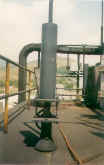
|
Magnetic
Impulse Gravity Impact Rapper |
|

|
Electromagnetic
Reciprocating Rapper (vibrator) |
 |
Pnuematic Rapper (vibrator)
|
 |
Mechanical Tumbling Hammer Rapping (American design,
in penthouse area) |
|

|
Mechanical
Tumbling Hammper Rapping
(European
design, in ESP gas stream)
|
|
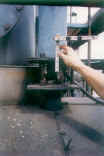
|
Magnetic impulse gravity impact rapper
piston / slug exposure between the rapper housing and the rapper rod
should be adjusted to the manufacturer specification and should be
consistent for all rappers. Proper
adjustment positions the rapper piston in the rapper coil equally
for all rappers and will help assure consistency of lift height.
Variations can affect rapper lift significantly.
The two rappers shown at TOP and CENTER would have significantly different
lifts when energized at the same control setting.
Rappers also need to be properly mounted and plumb.
Improper mounting can cause excessive wear of the coil, coil
sleeve and piston. The
sleeve has separated from the coil and dropped out of the rapper
housing BOTTOM because the mounting was not plumb.
Piston magnetization is another potential problem to be aware
of when inspecting a rapper system utilizing this style of rapper. |
|
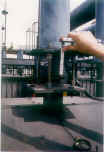
|
|
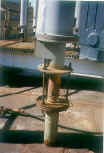
|
|

|
Rapping system failure, or insufficient
rapping can lead to excessive material buildups on the collecting
surfaces and discharge electrodes which can inhibit corona
generation and limit performance of the ESP.
Buildup on the tumbling rapper hammers in the photo TOP indicates the rapper shaft has not been operating.
The buildups on the electrodes and/or collecting plates in
the photos TO LEFT are the result of insufficient, or no, rapping.
The SECOND photo shows buildup on a wire
discharge electrode that has increased the diameter of the electrode
to approx. 2 inches. THIRD
photo shows
the rigid discharge electrode (RDE) is coated with material.
The clean RDE at BOTTOM was in a nearby gas passage where the
high voltage rappers where operational.
Please note that material buildup on the electrodes and
collecting plates can have causes other than rapping related. |
|
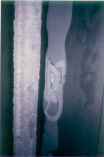
|
|

|
|

|
|

|
This insulated rapper rod
has failed due to too high intensity rapping or binding of the rod
in the roof penetration. |
|
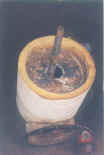
|
Misalignment of
the high voltage rapper rod and upper flange of the insulator
housing have caused binding of the rapper rod.
This will diminish the transfer of rapping energy.
|
|
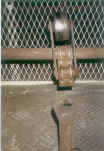
|
The
armature on this tumbling hammer is bent.
This causes the rapper to strike the anvil at an angle and
will cause metal fatigue and eventual failure of the rapper hammer. |
|
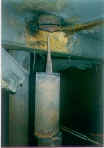
|
Corrosion has
reduced the diameter of this rapper rod to the point of failure.
This can result from inleakage at the boot seal, insufficient
purge blower / heater operation, and or temperature transition
through acid dewpoint.
|
Back to APC
Network Main Page
|
